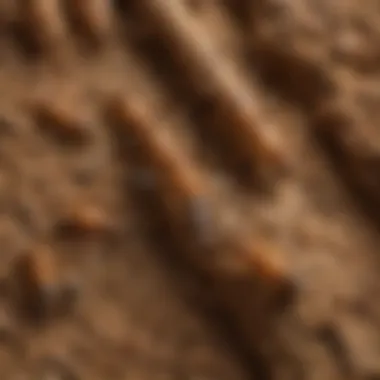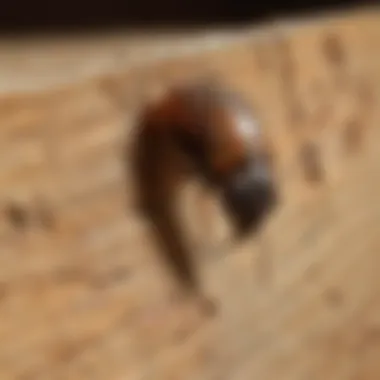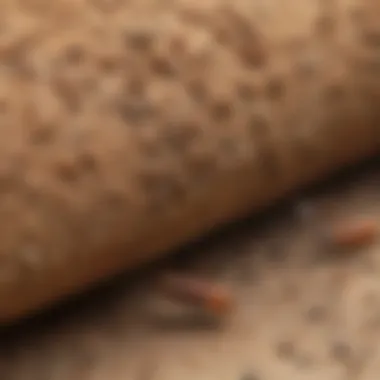Understanding Termite Completion Reports: A Deep Dive


Intro
A termite completion report is a critical tool for home and property owners. This document emerges after the pest inspection process, summarizing the presence, damage, and treatment of termite infestations. For homeowners, comprehending the intricacies of this report is essential for effective pest management and property maintenance.
Understanding the components of the report allows property owners to make informed decisions. The details outlined in this document not only inform on the current state of the property but also guide future pest prevention strategies. The implications of ignoring this report can be significant, potentially leading to extensive damage and costly repairs.
In this article, we will analyze various aspects of the termite completion report, from understanding the biology of the pest itself to effective control methods that include chemical and biological options. This guide is tailored for homeowners looking to maintain a pest-free environment.
Understanding the Pest
Identification
Termites are often mistaken for ants. Their form and habitats can vary, leading to confusion. The most common types affecting homes are subterranean, drywood, and dampwood termites.
- Subterranean Termites: They thrive underground, forming colonies in the soil that can extend for miles. These termites are typically the most destructive.
- Drywood Termites: They establish colonies within the wood they consume. This group does not require contact with soil.
- Dampwood Termites: They prefer moist and decaying wood. As a result, they often infest areas with high humidity.
Life Cycle
Understanding the life cycle of termites is crucial. The cycle consists of several stages:
- Eggs: Laid by the queen, these eggs hatch into nymphs.
- Nymphs: These young termites develop into workers, soldiers, or reproductive adults.
- Workers: They maintain the colony, gather food, and care for the young.
- Soldiers: Their role is to protect the colony from predators.
- Reproductives: Once conditions are favorable, they leave to establish new colonies.
This life cycle emphasizes the importance of early detection and treatment to prevent extensive damage.
Pest Prevention Strategies
Environment Modification
Keeping your property free from termites begins with modifications in its environment. Here are some steps that can help:
- Reduce moisture levels: Ensure that gutters are clean and that water is draining properly away from the foundation.
- Seal entry points: Examine cracks in walls and foundations, sealing gaps that may allow access.
Physical Barriers
Implementing physical barriers can further safeguard your property:
- Steel mesh: Installing fine mesh around the foundation can block termites.
- Concrete barriers: Using concrete wherever possible can make it harder for subterranean termites to access the structure.
These strategies enhance the overall defense against termite infestations.
Control Methods
Chemical Control
Chemical treatments are often the go-to solutions for termite problems. Common options include:
- Termiticides: These are applied to the soil to create a barrier.
- Boric acid: This offers a more environmental-friendly approach in infested locations.
Biological Control
Biological control methods use natural predators of termites. Fungi and nematodes can help in establishing a more sustainable approach to termite management.
Combining various strategies generally yields the best results in preventing and controlling termite infestations.
Prelude to Termite Completion Reports
Termite completion reports play a vital role in pest management and safeguarding properties. These reports serve as an essential record for homeowners, investors, and real estate professionals. Understanding this document allows one to grasp the current state of their property concerning termite threats.
By analyzing the details within a termite completion report, homeowners can make informed decisions for maintenance and prevention actions. Not only do these reports outline any infestations and their respective treatments, but they also highlight preventive measures that can be taken moving forward.


Having a well-documented termite completion report adds value to a property. It reflects diligence in property care and can influence the buying or selling process. As such, being aware of its content is crucial for ensuring a pest-free environment and maintaining property integrity.
Definition of a Termite Completion Report
A termite completion report is a formal document that summarizes the findings and actions taken during a termite inspection. This report is often produced by pest control professionals after conducting an assessment of a property.
The document typically includes details about the property's condition, specified areas inspected, and any noted signs of termite infestation. It might also reference the types of termites identified and describe the treatment methods applied. The clarity of the report ensures that property owners understand what actions have been taken and what further steps, if any, are recommended.
Purpose and Importance
The primary purpose of a termite completion report is to inform property owners about their termite situation. It summarizes inspection findings and outlines treatment recommendations. Knowing the extent of any damage is vital for timely intervention, which can save significant repair costs in the long term.
The importance of such reports cannot be overstated. They are not only helpful for immediate pest control measures. They also serve as essential documentation for future reference, especially when selling or buying property. A thorough, clear report provides assurance to potential buyers that the property has been carefully inspected and managed, thereby facilitating trust and transparency in real estate transactions.
"A well-structured termite completion report is your shield against unexpected pest-related expenses."
Understanding these reports equips homeowners with the knowledge needed to act responsibly regarding termite issues. By engaging with the report's findings, they can take preventive measures to maintain a pest-free and valuable home.
In summary, termite completion reports are crucial for maintaining property security and making informed decisions related to pest control. Homeowners who understand these documents are better positioned to protect their investments.
Components of a Termite Completion Report
A termite completion report serves as a detailed account of the inspection and treatment regarding termite activity in a property. Understanding the components of this report is essential for homeowners and pest control professionals alike. Each element of the report carries specific information that can influence how one manages potential risks associated with termite infestations.
The components generally include property details, inspection findings, treatment recommendations, and follow-up actions. Grasping the significance of these sections can help in making informed decisions, whether it's about immediate actions or long-term home maintenance strategies.
Property Details
The property details section provides necessary background about the location being inspected. This can include the address, type of structure, and age of the property. Understanding these specifics helps to create a context for the inspection findings. For example, older homes may have more vulnerabilities due to wear and tear, while certain materials used in construction may attract termites.
Additionally, the details in this section can also cover the current state of landscaping, as factors like moisture retention from plants can contribute to termite presence. Homeowners should pay careful attention here; the characteristics of the property influence not only the risk of infestation but also how treatment should proceed.
Inspection Findings
In the inspection findings section, the report outlines observations made during the inspection process. This may include signs of existing infestations, such as mud tubes, discarded wings, or visible damage to wood. The clarity and detail of this information are critical. If a findig indicates termite activity, it implies urgent remedial measures. Conversely, a clean report could offer peace of mind.
Homeowners should understand the implications of every finding. A finding confirming activity can compel timely treatments. By contrast, a lack of findings could encourage some preventive measures instead. It is also vital to differentiate between active infestations and old damage, as this can dictate different approaches.
Treatment Recommendations
The treatment recommendations are pivotal in deciding how to deal with the termites, if present. This section outlines the options available, which may include chemical treatments, baiting systems, or physical barriers. Homeowners must carefully consider the pros and cons of each type of treatment.
Some treatment options may have a more immediate effect while others focus on long-term prevention. The right choice often depends on individual circumstances such as the severity of the infestation and the property type. Homeowners should consult with pest management professionals to clarify doubts and engage in informed discussions regarding these options.
Follow-up Actions
Finally, the follow-up actions subsection emphasizes the need for ongoing monitoring and additional treatments as necessary. This is vital for maintaining a pest-free environment. Follow-up actions may involve scheduling regular inspections or making adjustments to landscaping and other property aspects that could harbor termites.
Homeowners should not overlook follow-up recommendations. Implementing these actions can significantly reduce the risk of future infestations. Regular check-ins ensure that treatment measures are effective, maintaining the structural integrity and longevity of the home.
"Effective management of termites requires both immediate action and long-term strategies to prevent recurrent issues."
By understanding these components of a termite completion report, homeowners can navigate the complexities of pest management more confidently. Knowing what to look for and which steps to take is crucial for preserving property values and ensuring peace of mind.
The Process of Termite Inspections
The process of termite inspections is critical in ensuring a property's protection against these destructive pests. A thorough examination can reveal hidden infestations and structural vulnerabilities. Understanding this process equips homeowners with insights that can save time and money by implementing early interventions. It can prevent extensive damage and foster peace of mind regarding the property's safety.
Preparation for Inspection
Before an inspection, preparation is key. Homeowners should make the environment accessible for the inspector. This involves clearing areas like basements, attics, and crawl spaces. Removing clutter allows for a comprehensive evaluation. Furthermore, it is important to inform the inspector about previous pest issues.


On the day of the inspection, ensure all entry points are available for easy access. Homeowners should also remove any obstructive landscaping that could hinder the inspection. Thorough preparation enhances efficiency and effectiveness.
Inspection Techniques
Professionals use various inspection techniques to assess properties effectively. Tools such as moisture meters, flashlights, and sometimes thermal imaging cameras may be involved.
Inspectors often start from the exterior of the home, looking for potential entry points. They examine the foundation, siding, and any wooden structures closely. The inspection may move inside, focusing on the basement, attic, and crawl spaces. Technicians will also check for any signs of past treatments, which is helpful to assess the property's history.
Each technique aims to gather as much information as possible, ensuring a comprehensive final report that will direct future actions.
Identifying Signs of Infestation
Recognizing signs of infestation is vital in termite management. Inspectors look for droppings, mud tubes, or damaged wood. Termite droppings resemble small pellets and may be found near infested areas. Mud tubes lead from the ground to the wooden structures and indicate active infestations.
Aside from physical evidence, inspectors pay attention to any changes in the property's structure. Unexplained cracks or unusual sounds can also hint at termite activity. Timely identification of these signs is crucial in preventing further damage.
Understanding these signs empowers property owners to act swiftly, mitigating extensive damage.
In summary, the process of termite inspections is a methodical approach to safeguarding a property from termite damage. Adequate preparation, expert inspection techniques, and the ability to identify signs of infestation all contribute to the effectiveness of this essential preventive measure.
Types of Termite Treatments
Understanding the various types of termite treatments is crucial for homeowners. This knowledge helps in deciding on the best course of action when faced with a termite issue. The effectiveness of treatments varies, and understanding the options can guide decision-making based on factors like environment, severity of infestation, and budget.
Chemical Treatments
Chemical treatments often form the first line of defense against termites. These treatments involve the application of pesticides, known as termiticides, to create a barrier that prevents termites from entering a structure. There are two main types of chemical treatments: liquid soil treatments and bait systems.
- Liquid soil treatments are applied around the foundation of the home and can kill termites on contact as well as provide long-lasting protection. When properly applied, these chemicals can remain effective for several years.
- Bait systems, on the other hand, work by attracting termites to bait stations loaded with slow-acting insecticides. This method can be effective for eliminating colonies, as it allows termites to take the bait back to the nest, thereby impacting the entire colony.
It's important to note that chemical treatments require skilled professionals to ensure correct application and effectiveness. Homeowners should seek licensed pest control services for this.
Alternative and Eco-Friendly Solutions
In recent years, the interest in eco-friendly solutions for termite management has increased significantly. Alternative treatments may be safer for the environment and people’s health while still being effective against termites.
- Borate treatments are a popular eco-friendly option. Borate, a naturally occurring mineral, can be applied to wood structures to prevent infestations. It works by being absorbed by the wood, making it toxic to termites while safe for humans and pets.
- Nematodes, microscopic worms that feed on termites, are another method. They are introduced into the infested areas and seek out and kill termites, providing a biological control method.
- Fumigation can also be considered if the infestation is severe. While it uses chemicals, modern methods often minimize their environmental impact.
Choosing alternative treatments may require more research and patience. Homeowners should consult pest professionals about their effectiveness and suitability.
Prevention Strategies
Even with effective treatments in place, prevention remains the best strategy against termite infestations. Homeowners can implement several measures to keep their homes pest-free:
- Regular Inspections: Conduct annual inspections for early detection. This can identify potential weaknesses where termites may enter.
- Moisture Control: Termites are attracted to moisture. Fixing leaks, improving drainage, and using dehumidifiers can eliminate conducive conditions for termites.
- Proper Landscaping: Keep mulch, wood piles, and vegetation away from the foundation. This reduces feeding opportunities near the home.
- Foundation Maintenance: Seal cracks and openings in the foundation and sill plates. This helps reduce entry points for termites.
Taking proactive measures and being vigilant are essential in maintaining a termite-free home. Homeowners should remain informed about treatments and preventative steps, as this can save both time and money in the long run.
Interpreting the Findings of the Report
Interpreting the findings of a termite completion report is critical for homeowners and property managers. This section breaks down the core aspects that are essential for fully understanding the report's implications. A nuanced interpretation of the report not only allows owners to grasp the extent of any infestation but also informs them about necessary actions. Each finding carries significance, and recognizing these details can save time and costs in the long run.
Understanding Terminology
The language of termite reports can be technical and complex. Understanding the terms used is the first step in interpreting the findings. Terms like "infestation," "treatment efficacy," or "bait stations" need clarification. If the report states signs of "active infestation," it indicates a live presence of termites, necessitating immediate action. Likewise, knowing whether the report refers to subterranean or drywood termites can affect treatment decisions. Homeowners should not hesitate to ask professionals for explanations of any unfamiliar jargon to ensure clarity.
Analyzing Recommendations
Recommendations in the termite completion report are usually tailored to the specific situation observed during the inspection. These suggestions detail the types of treatments required and any necessary preventative measures. For example, if the report recommends chemical barriers, it might indicate a more severe infestation that requires immediate action. Analyzing these recommendations involves assessing their relevance and practicality based on one's specific circumstances. Homeowners should weigh options, consider budgets, and evaluate the long-term benefits of each suggestion made in the report.


Assessing the Urgency Level
Not all findings in a termite report demand immediate action. Some issues may be more pressings than others. Assessing the urgency involves looking at both the severity and extent of any infestations mentioned. For instance, a high-level infestation in the structural wood of a building may call for prompt action, whereas minor signs of termites in a less critical area could allow for a delay. Homeowners should prioritize their actions based on this urgency to effectively allocate resources and time. It is important to communicate with pest control professionals to clarify any doubts regarding urgency.
It is crucial to not only read the findings of the termite report but to fully understand the implications behind each point to effectively manage the risk to property.
Interpreting the findings of a termite completion report thus becomes a powerful tool for informed decision-making. By understanding terminology, analyzing recommendations, and assessing urgency, homeowners position themselves to take effective action in pest management.
Legal and Insurance Considerations
Understanding the legal and insurance implications surrounding termite completion reports is crucial for homeowners. These reports can influence not only the health of your property but also your financial obligations and potential liabilities. By being aware of your rights and responsibilities, you can make informed decisions based on the findings of these reports.
Disclosure Requirements
Homeowners must fulfill specific disclosure requirements when selling their property. This often includes revealing any history of termite infestations or treatments. Failure to disclose such information can lead to legal repercussions. Moreover, many states have laws stipulating that sellers must provide documentation of any termite inspections. It is vital to keep records of your termite inspections and treatments. Doing so not just assists in transparency during a sale but also builds a solid case if disputes arise later.
Impact on Property Value
The presence of termites can substantially affect property value. Buyers generally look for assurance that a property is free from pest issues. If a termite completion report reveals existing or past infestations, prospective buyers may undervalue the property or demand repairs before proceeding with a purchase. Addressing these issues proactively can maintain or even enhance property value. Regular inspections and treatments can serve as proof of diligence to future buyers.
Insurance Coverage for Termite Damage
Insurance coverage for termite damage varies widely among polices. Some homeowners' insurance policies do not cover damages caused by wood-destroying insects, including termites. It is essential to review your policy thoroughly to understand your coverage. If your policy excludes termite-related damages, consider specialized pest control insurance or warranties offered by pest management companies. Having the right insurance can safeguard your investment against unforeseen termite issues.
"Proactive measures, including thorough documentation and understanding your insurance coverage, will empower homeowners in managing termite risks effectively."
By paying attention to these legal and insurance aspects, homeowners can better navigate the implications of termite management and protect their investments.
Best Practices for Homeowners
Homeowners play a crucial role in managing and preventing termite infestations. Understanding and implementing best practices is essential for safeguarding a property. This section highlights strategies for effective termite management, ensuring not only the protection of the property but also the health and safety of its occupants.
Regular Inspections and Monitoring
Conducting regular inspections is a key strategy in termite prevention. Homeowners should engage pest control professionals at least once a year. These inspections can detect early signs of termites, like mud tubes or damaged wood, before they escalate into more substantial issues.
The importance of monitoring extends beyond annual inspections. Homeowners should routinely check for visible signs of termites, especially in warm seasons when termites are most active. Areas typically at risk include:
- Basements and crawl spaces
- Decks and patios
- Around windows and doors
- Wooden structures like sheds or fences
Implementing a monitoring system can also be beneficial. For instance, placing bait stations around the perimeter of a home helps to monitor termite activity. If termites are present, it allows for quick action to be taken.
Maintaining a Pest-Free Environment
Creating an environment that discourages termites is essential for prevention. Homeowners can take multiple steps to maintain a pest-free zone:
- Reduce Moisture: Termites thrive in damp conditions. Homeowners should fix leaks in plumbing and ensure proper drainage around the foundation. Keeping gutters clean also prevents water buildup.
- Proper Landscaping: Keep plants and wooden mulch away from the foundation. Maintaining a barrier of at least six inches between ground materials and wood can deter termites.
- Regular Yard Maintenance: Trimming trees and shrubs can help prevent termites from gaining access to the home. Avoid allowing wood piles to sit close to the house, as they provide a direct food source for termites.
- Seal Entry Points: Inspect your home for cracks and gaps. Sealing these areas can prevent termites from entering your property.
"An ounce of prevention is worth a pound of cure." By being proactive and attentive, homeowners can significantly reduce the risk of termite infestations.
Epilogue
The conclusion serves as a pivotal moment in the discourse surrounding the termite completion report. It consolidates the insights gleaned from various sections, emphasizing the significance of understanding such a report for homeowners. Having a clear grasp of the components and findings empowers property owners to take informed actions, ultimately protecting their investments from potential damage.
Summary of Key Points
The termite completion report encompasses critical information regarding inspection findings, treatment recommendations, and follow-up actions. Each of these elements plays an essential role in the overall termite management strategy. Property details are equally important, as they set the context for any pest-related issues discovered during inspections.
- Inspection Findings: These highlight the state of infestation and potential risks.
- Treatment Recommendations: They guide homeowners towards suitable pest control measures.
- Follow-up Actions: These ensure ongoing monitoring to prevent future infestations.
By recognizing these components, homeowners can proactively address termite issues, ensuring their property remains safe and intact.
Future Considerations
Looking ahead, the relevance of termite completion reports is likely to grow as awareness of pest management increases. Homeowners should consider implementing an annual inspection regimen, as timely detection of infestations reduces the severity of damage and treatment costs. Moreover, developments in pest control methods will continue evolving.
- Innovative Treatments: Stay informed about eco-friendly options that may become available.
- Regulatory Changes: Understanding local laws concerning pest management can also impact decisions.
- Technology Integration: The rise of smart home technology may offer new ways to monitor pest issues in real time.





